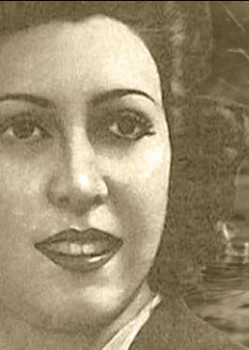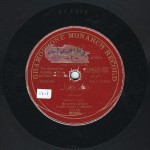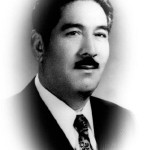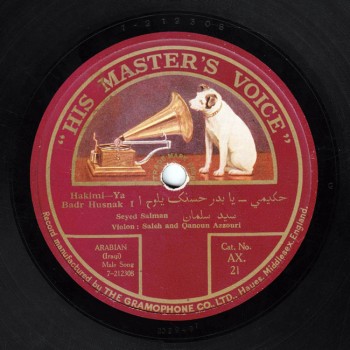 The Arab Music Archiving and Research foundation (AMAR), in collaboration with the Sharjah Art Foundation (SAF), presents “Durūb al-Nagham”.
The Arab Music Archiving and Research foundation (AMAR), in collaboration with the Sharjah Art Foundation (SAF), presents “Durūb al-Nagham”.
Dear listeners,
Welcome to a new episode of “Durūb al-Nagham”.
Today, we will resume our discussion about the Iraqi maqām with Mr. Ḥusayn al-A‘ẓamī.
We have already discussed main maqām in detail. Let us now talk about sub-maqām and cyclic rhythms, i.e. the rhythmic cycle accompanying some maqām… as the elements of the maqām are not complete if not accompanied by a rhythmic cycle.
Sub-maqām include more freedom –as I stated earlier while discussing the sikāh ḥakīmī…
(♩)
This was an example of the maqām ḥakīmī –a sikāh sub-maqām– that is “free” and whose music must abide by the Iraqi 12/4 yugrug rhythm…
(♩)
This maqām is also among those sung in local colloquial poetry/accent.
Baghdadi.
The Baghdadi or Iraqi accent called zuhayrī poetry.
Let us listen to a maqām sung in zuhayrī poetry –which you just illustrated for us, Mr. Ḥusayn–. Here is the maqām ḥakīmī sung by Mr. Salmān –as printed on the disc’s sleeve… probably Salmān Mosheh–. The recording was made around 1924 by His Master’s Voice. The accompanying jālghī (ensemble) includes Ṣāliḥ Shumāyil (jawza) and Za‘rūr al-Kabīr (qānūn), percussionists unknown –I wish someone would tell us who they are, then we would know all the jawq members accompanying Mr. Salmān…
(♩)
Zuhayrī poetry is a type of popular/folk poetry made of seven hemistiches: the first three hemistiches end with a word that has the same pronunciation but a different meaning, i.e. a jinās (homonym).
Like the mawwāl.
Exactly. This word –not a letter as in literary poetry– constitutes the rime.
A jinās tāmm (complete homonym).
Yes… the same pronunciation, a different meaning.
Again, the following three hemistiches end with a new word that has the same pronunciation but a different meaning.
The seventh hemistich ends with the rime of the first three hemistiches yet with a different meaning.
This was the zuhayrī sung in numerous maqām: those sung in popular colloquial poetry, and those sung in literary poetry.
Some maqām are sung in both.
Indeed. There is, for example, the maqām ‘araybūn: both the ‘araybūn ‘ajam ḥijāz and the ‘araybūn ‘arab bayyātī are sung to one maqām: the ‘araybūn ‘ajam starts with the ḥijāz, and the ‘araybūn ‘arab starts with the bayyātī. As follows…
(♩)
This was an example of the beginning of the ‘araybūn ‘ajam.
Here is the ‘araybūn ‘arab…
(♩)
This was an example of the ‘araybūn ‘arab…
In such cases, there are two taḥrīr and two mayāna…
All these details are included… This is a major maqām.
The taḥrīr of the ‘araybūn ‘ajam is different from the taḥrīr of the ‘araybūn ‘arab… The mayāna and the waṣla are different…
Of course… the scale is different, the words are different, many points are different… Yet both are taḥrīr, i.e. the first verses of both maqām.
There is a large variety of maqām, including maqām sung in literary poetry and maqām sung in popular/folk poetry, added to main maqām and sub-maqām –small and big, as some sub-maqām that include numerous “qiṭa‘ and awṣāl” that became fixed with time are big/major maqām closer to main maqām.
What about the recordings of different maqām put together?
This would be a vocal waṣla.
Sometimes in concerts, I sing poetry with the abbūdhiyya (popular/folk poem) to the bayyātī / nawa. After the poem with the abbūdhiyya and the song that follows, I can sing the maqām dasht that is a bayyātī ḥusaynī / nawa, and I can interpret a poem and another abbūdhiyya this time to the maqām ṣabā, I can also sing it to the same note.
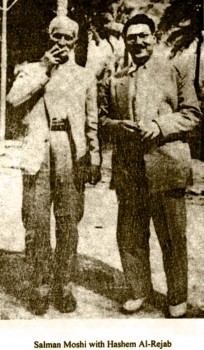 This remains within the Iraqi maqām.
This remains within the Iraqi maqām.
These vocal waṣla are not model waṣla. The model is the maqām by itself: when we record examples for teaching or documentation/archiving purposes, the maqām is sung individually as a model. Whereas, a 2-hour’ long waṣla can include modulations between maqām throughout the whole duration… It all depends on the harmony of the modulations between the scales, the maqām, and the songs. This harmony mainly concerns the scale-step, i.e. the fundamental note and the sung note that must be in harmony with the modulation: for example: the ‘ajam would be on a certain scale-step that changes when we modulate to the nahāwand.
These are scientific facts.
Someone with an ear for music, even one who has not studied music, often achieves it, such as the Kuran reciter who did not study music yet recites the Holy Kuran with variations in his modulations. He may not be aware of what he is doing yet he modulates correctly from one maqām to another and from one scale to another… Human beings have the ability to instinctively feel or distinguish right from wrong.
…Or harmony from dissonance.
Harmony and dissonance… Very often, someone would come to us saying he feels there is something wrong without knowing what it is. He just feels it, while we, as experts, can pinpoint it.
Is the basta compulsory in the Iraqi maqām?
Of course. The basta is a light song whose structure is simple, that is sung to give the muṭrib some rest.
In fact, songs were coupled with maqām… If we go back to the religious rites such as the manqaba nabawiyya (made of 5 faṣl –some say 6 faṣl– in the past and only including one faṣl today), each faṣl includes 6, 7, or 8 maqām, and lasts for an hour or more.
The measured religious shughl –neither called a song nor a basta, yet also called tanzīla– between one maqām and another allows the individual performer who interpreted the maqām to rest, either in the religious faṣl or in the Iraqi maqām.
As you said earlier Mr. Mustafa, different maqām can be performed while singing. The song –basta– is there to give the muṭrib some rest.
In religious rites such as the manqaba nabawiyya, the measured shughl and tanzīla are performed by the ensemble while the qāri’ stops to rest and to get ready to perform another maqām after the shughl and the tanzīla are performed by the ensemble.
In singing, the basta is performed by the ensemble to give some rest to the individual performer in between maqām when he has numerous maqām to sing.
Beautiful. So each maqām must preferably be followed by a basta.
Of course… Each maqām has its own spirit: the banjkāh is a rāst; the sharqī maqām rāst is also a rāst, yet their spirit is different. We could sing another maqām to the rāst too, and its spirit would also be different… like this sharqī ‘ushshāq for example. This is an important point: the basta’s spirit must be the same as the maqām’s. I could sing the banjkāh and the rāst, and the result would be harmonious since the scale is the same. But, from an expression or a spirit angle, the result would be better if the spirit is the same as the spirit of the maqām I performed, i.e the banjkāh. The basta was made to be harmonious with the expressions of the maqām.
Then it is not advisable to sing “Qaddim-lī burhānak” after the maqām banjkāh, whereas singing “Hādhā huwa inṣāf minnak” would be.
Yes, of course.
“Hādhā huwa inṣāf minnak” is a banjkāh ṣirf, as per its expression and as per its uṣūl: the madhhab is a banjkāh rāst and the couplet is a ḥijāz, the same as in the maqām that we broke down into five sections.
Like the waṣla.
Exactly. “Hādhā huwa inṣāf minnak” is like a measured maqām banjkāh.
Let us listen to “Hādhā huwa inṣāf minnak”.
Ok. Do you have it here?
Let us listen to it performed by Sayyida Salīma Murād known on disc sleeves and socially as Sitt Salīma Bāshā.
(♩)
After we have listened to the banjkāh basta, would you like to add something to complete our discussion about the maqām? Is there any additional information about the maqām you would like to tell our listeners?
Yes.
As we mentioned in the beginning, religious signs were present in maqām throughout the past centuries. These maqām performances were associated with religious rites through which the concept of the mundane Iraqi maqām muṭrib showed and gradually matured, especially in the 19th century. I mentioned this fact in my book about the ṭarīqa zaydāniyya in relation to famous 19th century mundane muṭrib Aḥmad al-Zaydān born in 1832 and deceased at age 80 in 1912, and who was at the same time a religious munshid. All Iraqi maqām muṭrib, until today –I think– can’t develop the expressive concept pertaining to Iraqi maqām without practising religious rites in order to gain instinctively and spontaneously the real or right expressions. I stated that heritage is acquired and not given: I teach at the institute where students come from either a different or the same environment/mentioned. If these students have practised/heard/attended religious rites in order to acquire spontaneously the real expressions of maqām, one notices, when they perform mundane Iraqi maqām singing, that they own them. I can’t teach expressions because they are sensations. Heritage is acquired/appropriated, it is not given. The same as I would teach mathematics, I could teach students uṣūl and maḥaṭṭa that go through a certain scale, a certain jins… Whereas expressing can’t be taught/learned, it is acquired from the environment/milieu. Consequently. Some of the problems pertaining to teaching consist in searching for students who own the religious practice, and on whom teaching would thus not be wasted, while the others are not fully ready to sing maqām and might have to sing modern songs…etc. So, the concept of a mundane Iraqi singer matures on a religious principle. No muṭrib can succeed in maqām without practising religious rites in order to own the real expressions of maqām. This remains an important point until today, and I think that this principle concerns all the heritage and is not limited to Iraqi maqām.
I have hundreds of questions and doubts concerning the competence and authority of the western academic system in teaching Arab music. Anyway, I will not start this discussion as it would necessitate numerous episodes.
(♩)
Dear listeners,
We have reached the end of today’s episode about the maqām ‘irāqī.
We thank the great muṭrib Mr. Ḥusayn al-A‘ẓamī.
We will meet again in a new episode to discuss a new subject pertaining to the numerous durūb al-nagham/musical paths in the Arab World.
“Durūb al-Nagham”.
- 221 – Zakariyya Ahmed – 12 (1/9/2022)
- 220 – Zakariyya Ahmed – 11 (1/9/2022)
- 219 – Zakariyya Ahmed – 10 (11/25/2021)
- 218 – Zakariyya Ahmed – 9 (10/26/2021)
- 217 – Zakariyya Ahmed – 8 (9/24/2021)
- 216 – Zakariyya Ahmed – 7 (9/4/2021)
- 215 – Zakariyya Ahmed – 6 (8/28/2021)
- 214 – Zakariyya Ahmed – 5 (8/6/2021)
- 213 – Zakariyya Ahmed – 4 (6/26/2021)
- 212 – Zakariyya Ahmed – 3 (5/27/2021)
- 211 – Zakariyya Ahmed – 2 (5/1/2021)
- 210 – Zakariyya Ahmed – 1 (4/28/2021)
- 209 – W-al-Lāhi lā astaṭī‘u ṣaddak 2 (4/6/2017)
- 208 – W-al-Lāhi lā astaṭī‘u ṣaddak 1 (3/30/2017)
- 207 – Bashraf qarah baṭāq 7 (3/23/2017)

